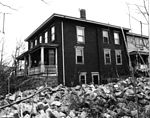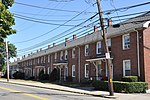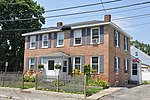Newton Street Bridge
1877 establishments in MassachusettsBridges completed in 1877Bridges in Middlesex County, MassachusettsBridges over the Charles RiverBuildings and structures in Waltham, Massachusetts ... and 7 more
Massachusetts building and structure stubsMassachusetts transportation stubsNational Register of Historic Places in Waltham, MassachusettsNortheastern United States bridge (structure) stubsRoad bridges on the National Register of Historic Places in MassachusettsStone arch bridges in the United StatesWaltham, Massachusetts Registered Historic Place stubs

The Newton Street Bridge is a historic bridge carrying Newton Street over the Charles River in Waltham, Massachusetts. The stone arch bridge was built in 1877 on the site of Waltham's first bridge, which was built c. 1761–62. It was designed by Hiram Blaisdell, a specialist in the design of masonry bridges. It consists of three elliptical arch segments on granite piers. The arches are formed of granite voussoirs, and the facing of the bridge is predominantly rough rock. It is the only 19th-century bridge in Waltham to escape significant alteration.The bridge was listed on the National Register of Historic Places in 1989.
Excerpt from the Wikipedia article Newton Street Bridge (License: CC BY-SA 3.0, Authors, Images).Newton Street Bridge
Charles River Greenway, Waltham
Geographical coordinates (GPS) Address Nearby Places Show on map
Geographical coordinates (GPS)
| Latitude | Longitude |
|---|---|
| N 42.372222222222 ° | E -71.229166666667 ° |
Address
Charles River Greenway
Charles River Greenway
02453 Waltham
Massachusetts, United States
Open on Google Maps











